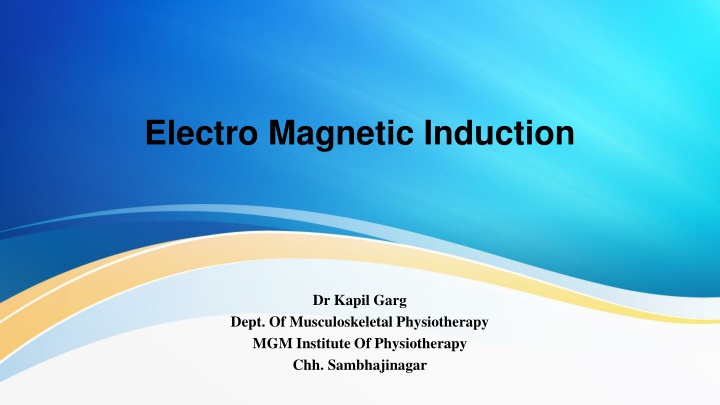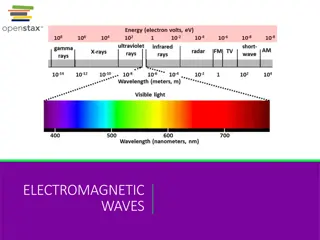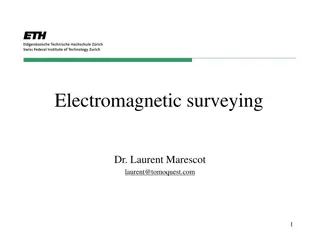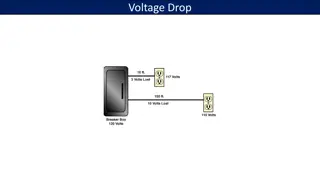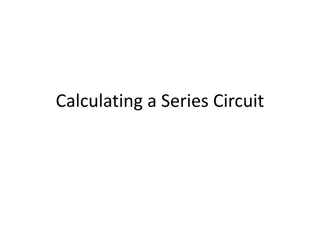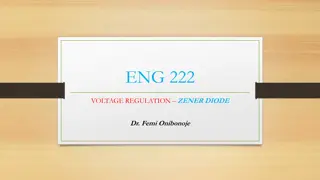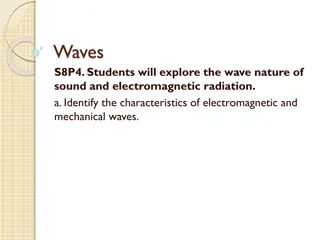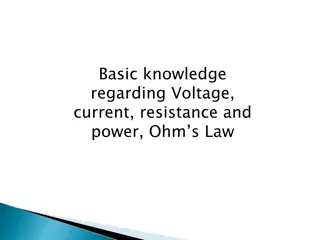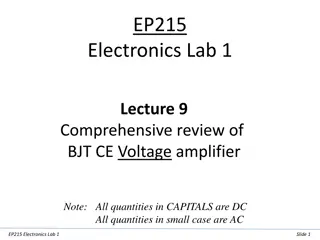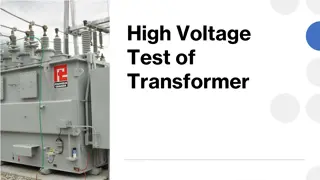Electromagnetic Induction Explained: Production of Voltage & Current
Electromagnetic induction is the process of generating an electromotive force in a conductor within a changing magnetic field. This phenomenon, first discovered by Michael Faraday, has various practical applications in electrical components such as inductors and transformers, as well as in devices like electric motors and generators. The concept involves using magnetic fields to induce voltage and current in a circuit, showcasing the fascinating relationship between electricity and magnetism. Explore the principles and applications of electromagnetic induction in this informative content.
Uploaded on Feb 25, 2025 | 1 Views
Download Presentation

Please find below an Image/Link to download the presentation.
The content on the website is provided AS IS for your information and personal use only. It may not be sold, licensed, or shared on other websites without obtaining consent from the author.If you encounter any issues during the download, it is possible that the publisher has removed the file from their server.
You are allowed to download the files provided on this website for personal or commercial use, subject to the condition that they are used lawfully. All files are the property of their respective owners.
The content on the website is provided AS IS for your information and personal use only. It may not be sold, licensed, or shared on other websites without obtaining consent from the author.
E N D
Presentation Transcript
Electro Magnetic Induction Dr Kapil Garg Dept. Of Musculoskeletal Physiotherapy MGM Institute Of Physiotherapy Chh. Sambhajinagar
Introduction Electromagnetic or magnetic induction is the production of an electromotive force (emf) conductor in a changing magnetic field. across an electrical Electromagnetic induction has found many applications, including electrical components such as inductors and transformers, and devices such as electric motors and generators.
Electromagnetic Induction is the process of using magnetic fields to produce voltage, and in a complete circuit, a current. Michael Faraday first discovered it, using some of the works of Hans Christian Oersted. His work started at first using different combinations of wires and magnetic strengths and currents, but it wasn't until he tried moving the wires that he got any success
Electromagnetic Induction Almost 200 years ago, Faraday evidence that a magnetic field would electric current with this apparatus looked for induce an
He when steady, current induced when the magnet moves down . found the no magnet did evidence was but see a up and
Magnetic Flux: Magnetic flux is the quantity of magnetic field that penetrates an area at right angles to it. Flux is a general term associated with a field that is bound by a certain area So Magnetic Flux is any area that has a Magnetic Field passing through it.
We generally define an area vector as one that is perpendicular to the surface of the material. Therefore, you can see in the figure that the area vector and the Magnetic Field vector are parallel. This produces a dot product between the 2 variables that then define flux.
Electromagnetic Induction Faradays Law Faraday s law of electromagnetic induction, also known as Faraday s law, is the basic law of electromagnetism which helps us predict how a magnetic field would interact with an electric circuit to produce an electromotive force (EMF). This phenomenon is known as electromagnetic induction.
Michael Faraday proposed the laws of electromagnetic induction in the year 1831. Faraday s law or the law of electromagnetic induction is the observation or results of the experiments conducted by Faraday. He performed three main experiments phenomenon of electromagnetic induction. (LAWS) to discover the
1. Faradays Law of Electromagnetic Induction Faraday s First Law of Electromagnetic Induction Faraday s Second Law of Electromagnetic Induction Lenz s Law Faraday s Law Derivation
Faradays First Law of Electromagnetic Induction The first law describes the induction of emf in a conductor Whenever a conductor is placed in a varying magnetic field, an electromotive force is induced. If the conductor circuit is closed, a current is induced, which is called induced current
Ways to change the magnetic field intensity in a closed loop By rotating the coil relative to the magnet. By moving the coil into or out of the magnetic field. By changing the area of a coil placed in the magnetic field. By moving a magnet towards or away from the coil.
Faradays Second Law of Electromagnetic Induction The induced emf in a coil is equal to the rate of change of flux linkage The flux linkage is the product of the number of turns in the coil and the flux associated with the coil. The formula of Faraday s law is given below
Lenzs Law The direction of the emf and thus the current is given by Lenz s law. Use this to find the direction of the current. If you are looking down on the loop from above, is the current flowing clockwise or counter clockwise? It is the most convenient method to determine the direction of the induced current.
The induced electromotive force with different polarities induces a current whose magnetic field opposes the change in magnetic flux through the loop in order to ensure that the original flux is maintained through the loop when current flows in it Lenz s Law is part of Faraday s Law and can help you determine the direction of the current provided you know HOW the flux is changing
Application Eddy current balances Metal detectors Eddy current dynamometers Braking systems on train AC generators Card readers Microphones
Electromagnetic Induction Useful Applications AC Generators use Faraday s law to produce rotation and thus convert electrical and magnetic energy into rotational kinetic energy. This idea can be used to run all kinds of motors. Since the current in the coil is AC, it is turning on and off thus creating a CHANGING magnetic field of its own. Its own magnetic field interferes with the shown magnetic field to produce rotation.
the magnitude of the induced emf in the conductor is equal to the rate of change of magnetic flux linked to the conductor electromagnetic induction, the EMF induced in the conductor is equal to the rate of change of flux linkage
Eddy Current Eddy currents are loops of electrical current induced within conductors by a changing magnetic field in the conductor according to Faraday s law of induction. Eddy currents flow in closed loops within conductors, in planes perpendicular to the magnetic field.
Induced electromotive force is produced in the coil when there is a change in the magnetic flux linked with that coil. Eddy currents are named so because the current looks like eddies or whirlpools. When a conductor is placed in the changing magnetic field, the induced current in the conductor is termed as Eddy current
Dynamo A dynamo is an electrical generator that utilizes a commutator to generate direct current. Dynamo is a device that converts mechanical energy into electrical energy. Dynamos were the first electrical generators utilized just to supply power to industry, as well as they served as the platform for several subsequent electric-power conversion types of equipment, such as the alternating-current (AC) alternator, electric motor, as well as a rotary converter.
Working of Dynamo: The image below shows a basic dynamo with such a coil constructed of conducting wires that are positioned between the North pole and South pole of two permanent magnets. Whenever the coil is to be motionless, no voltage is produced. The magnetic field changes as the coil spins, causing a voltage to be generated within the coil.
The left side of the coil travels from the North pole of such a left magnet during the first half of the revolution. The coil travels from the South pole of the right magnet throughout the second part of the revolution. There are two conceivable polarities throughout these rounds: Positive Negative An alternating voltage is a difference between their polarities.
Inductive resistance Inductive reactance, generally reactance, is the resistance of an inductive circuit. It is termed reactance since it fluctuates slightly from the resistance provided through any equipment or gadget. It is denoted by . The SI unit of inductive resistance is Ohm
